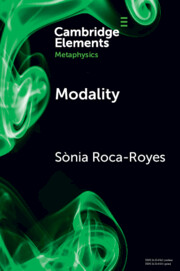Refine search
Actions for selected content:
34 results
Chapter 6 - Changing Minds
-
- Book:
- Knowledge Doesn't Exist and Other Thoughts on Critical Thinking
- Published online:
- 22 October 2025
- Print publication:
- 21 August 2025, pp 80-100
-
- Chapter
- Export citation
8 - Justifying Ownership
- from Part III - Property Law
-
- Book:
- Natural Property Rights
- Published online:
- 17 April 2025
- Print publication:
- 24 April 2025, pp 145-158
-
- Chapter
- Export citation
Conclusion
-
- Book:
- Pacifism and Non-Violence in Contemporary Islamic Philosophy
- Published online:
- 13 March 2025
- Print publication:
- 20 March 2025, pp 222-244
-
- Chapter
-
- You have access
- Open access
- HTML
- Export citation
2 - Caring for Cultural Heritage
-
- Book:
- Caring for Cultural Heritage
- Published online:
- 09 November 2023
- Print publication:
- 23 November 2023, pp 32-55
-
- Chapter
- Export citation

Modality
-
- Published online:
- 07 April 2023
- Print publication:
- 11 May 2023
-
- Element
-
- You have access
- Open access
- HTML
- Export citation
Reasoning Simplifying Attitudes
-
- Article
-
- You have access
- Open access
- HTML
- Export citation
Chapter 6 - FSK Motives and Profile
-
- Book:
- Just as Deadly
- Published online:
- 06 January 2023
- Print publication:
- 09 February 2023, pp 86-107
-
- Chapter
- Export citation
Chapter 23 - Kindness
- from Part II - Shakespeare’s Virtues
-
-
- Book:
- Shakespeare and Virtue
- Published online:
- 19 January 2023
- Print publication:
- 26 January 2023, pp 221-229
-
- Chapter
- Export citation
Who makes utilitarian judgments? The influences of emotions on utilitarian judgments
-
- Journal:
- Judgment and Decision Making / Volume 6 / Issue 7 / October 2011
- Published online by Cambridge University Press:
- 01 January 2023, pp. 580-592
-
- Article
-
- You have access
- Open access
- HTML
- Export citation
Infant baptism and the disposition to saving faith
-
- Journal:
- Scottish Journal of Theology / Volume 75 / Issue 4 / November 2022
- Published online by Cambridge University Press:
- 14 October 2022, pp. 363-373
- Print publication:
- November 2022
-
- Article
-
- You have access
- Open access
- HTML
- Export citation
Chapter 5 - Wisdom
- from Part I - Introduction to Wisdom Theory and Research
-
-
- Book:
- The Psychology of Wisdom
- Published online:
- 26 May 2022
- Print publication:
- 09 June 2022, pp 70-88
-
- Chapter
- Export citation
3 - Access to justice and open justice
- from Part I - Civil disputes and their means of resolution
-
- Book:
- Civil Dispute Resolution
- Published online:
- 18 January 2022
- Print publication:
- 13 December 2021, pp 61-84
-
- Chapter
- Export citation
Chapter 7 - Reasonable and Unreasonable Affections and Human Nature
- from Part III - Emotions, Reason, and the Natural World (Aristotle)
-
-
- Book:
- Ancient Ethics and the Natural World
- Published online:
- 13 August 2021
- Print publication:
- 12 August 2021, pp 125-144
-
- Chapter
- Export citation
Chapter 20 - Love
- from Part II - Emotions
-
-
- Book:
- Shakespeare and Emotion
- Published online:
- 01 October 2020
- Print publication:
- 22 October 2020, pp 288-301
-
- Chapter
- Export citation
2 - Aquinas on Original Justice
-
- Book:
- Aquinas, Original Sin, and the Challenge of Evolution
- Published online:
- 22 February 2020
- Print publication:
- 12 March 2020, pp 55-87
-
- Chapter
- Export citation
7 - The Human Appropriation of Justification
- from Part II - The Middle Ages
-
- Book:
- Iustitia Dei
- Published online:
- 27 January 2020
- Print publication:
- 13 February 2020, pp 118-145
-
- Chapter
- Export citation
Occurrent states
-
- Journal:
- Canadian Journal of Philosophy / Volume 48 / Issue 1 / 2018
- Published online by Cambridge University Press:
- 01 January 2020, pp. 1-17
-
- Article
- Export citation
(Re)conceptualising physical activity participation as career
-
- Journal:
- Ageing & Society / Volume 41 / Issue 4 / April 2021
- Published online by Cambridge University Press:
- 08 November 2019, pp. 936-954
- Print publication:
- April 2021
-
- Article
- Export citation
Part I - Courtly Society
-
- Book:
- The Courts of the Deccan Sultanates
- Published online:
- 05 July 2019
- Print publication:
- 18 July 2019, pp 29-164
-
- Chapter
- Export citation
1 - Courtly Disposition
- from Part I - Courtly Society
-
- Book:
- The Courts of the Deccan Sultanates
- Published online:
- 05 July 2019
- Print publication:
- 18 July 2019, pp 31-73
-
- Chapter
-
- You have access
- HTML
- Export citation
